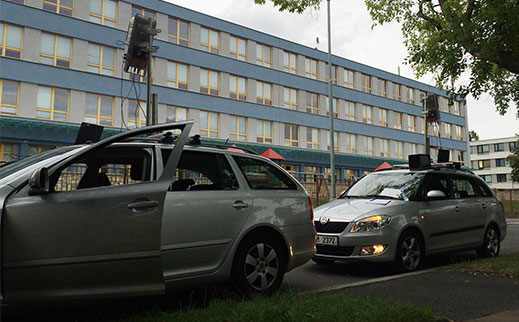Trick That Doubles Wireless Data Capacity Stands Up in Cell Network Tests
In 2012, startup Kumu Networks spun out of Stanford University to commercialize a clever trick with the potential to double the capacity of just about any kind of wireless data link. Recent tests by one of America’s largest wireless carriers and by Deutsche Telekom, the German telecom giant that owns a majority stake in U.S. carrier T-Mobile, have now shown that doubling is feasible in real cellular networks.

The results suggest that products Kumu Networks has in the works for cellular operators could help expand the capacity of mobile data networks. In the longer term, the company hopes to deliver further capacity boosts by making its technology compact enough to fit inside mobile devices.
Kumu originated in research that refuted the long-held assumption that radios cannot transmit and receive at the same time. That belief was based on the fact that if a radio tries to do both at once, its outgoing signal drowns out incoming ones, because it is billions of times stronger. For this reason, the radios in our phones and computers either use separate channels to send and receive or switch between sending and receiving on a single channel.
Kumu’s founders developed hardware and software that enables a radio’s receiver to filter out interference from outgoing signals. The device can then transmit and receive at the same time—what Kumu calls a “full duplex” connection—doubling the effective capacity of a single radio channel or making it possible to use one where two were needed before (see “The Clever Circuit That Doubles Bandwidth”).
This summer, Kumu worked with major wireless carriers on the first tests of its technology in real cellular network conditions.
Earlier this month, Deutsche Telekom, Germany’s largest telecom provider, installed a small LTE cell tower containing Kumu’s technology on a rooftop in Prague. Devices with Kumu’s technology mounted on top of cars played the role of cell phones linking to the network. In a series of trials, the test devices were sometimes moving or blocked by buildings, cars, or people from making a direct line-of-site connection with the tower. On the whole, the capacity-doubling trick worked in those varying conditions, says Steven Hong, director of product and a cofounder of Kumu.
The results echoed others from earlier this summer, when one of the largest U.S. carriers—which Kumu declines to name—carried out similar but smaller tests on its own LTE network in the area around Kumu’s office in Sunnyvale, California. “We were able to show doubling of spectral efficiency in all the conditions that we tested,” says Hong.
Harish Krishnaswamy, an associate professor at Columbia University, says Kumu’s trials suggest that the idea of full-duplex wireless connections can be practical, although the company has not made detailed results public. “The work coming out of Kumu is the first hint of realistic demonstration of this technology,” he says. “There are still some challenges but we’re seeing that this is possible.”
Hong agrees that challenges remain but says Kumu is working on them. For example, when the devices playing the role of phones in the trial were close together, they sometimes interfered with each other. And sometimes the technology didn’t adapt optimally fast to changing circumstances—for example, when a car went by.
Kumu’s first product will be aimed at wireless carriers and is a version of the small mobile base stations, known as small cells, used to improve coverage in busy locations such as stadiums. Small cells usually link back to a carrier’s network using cable. Kumu’s version will be cable-free and will use the full-duplex technology to simultaneously serve nearby devices and make a high-powered LTE link back to the core network. Making small cells fully wireless should help carriers deploy them in a wider range of places and improve data coverage and capacity, says Hong. He expects that carriers will test that product in the field, serving live traffic, next year.
Kumu is also working on a chip that will make it possible to shrink down the package containing the company’s technology from roughly the size of a hardback book to something more akin to a credit card. Earlier this year, Krishnaswamy’s group at Columbia demonstrated a full-duplex chip smaller than a fingertip. He’s confident that the technology will eventually arrive in phones. It is already being talked about in the industry as one part of a future 5G wireless data standard. “We’re maybe one or two years away from having something that can be deployed in mobile,” says Krishnaswamy.
Keep Reading
Most Popular
Large language models can do jaw-dropping things. But nobody knows exactly why.
And that's a problem. Figuring it out is one of the biggest scientific puzzles of our time and a crucial step towards controlling more powerful future models.
How scientists traced a mysterious covid case back to six toilets
When wastewater surveillance turns into a hunt for a single infected individual, the ethics get tricky.
The problem with plug-in hybrids? Their drivers.
Plug-in hybrids are often sold as a transition to EVs, but new data from Europe shows we’re still underestimating the emissions they produce.
Stay connected
Get the latest updates from
MIT Technology Review
Discover special offers, top stories, upcoming events, and more.